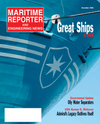
Page 13: of Maritime Reporter Magazine (December 2, 2006)
Read this page in Pdf, Flash or Html5 edition of December 2, 2006 Maritime Reporter Magazine
December 2006 13
The Naval
Institute Guide to World Naval
Weapon Systems - Fifth Edition
By Norman Friedman 2006, Naval Institute Press,
Annapolis
ISBN 1-55750-262-5
List Price: $250.00
Reviewed by Edward Lundquist
Alion Science and Technology
Norman Friedman has gathered the world's most complete listing and analy- sis of weapons, sensors and systems in his very readable Naval Institute Guide to World Naval Weapon Systems
The book catalogs changes in naval warfare development since the 1997- 1998 edition was published.
Remarkably, much has not changed.
Friedman covers both the old and the new.
What's new is better and faster com- munications, able to move more detailed intelligence and information faster,
Friedman says. While there are fewer weapon systems builders, the industrial capability is more sophisticated, manu- facturing smaller and more powerful semiconductors and moving informa- tion with greater speed and fidelity over fiber optics. Ground Positioning
Satellite (GPS) gives weapons pinpoint accuracy. With these improvements as well as computer aided design and man- ufacturing, weapons can be made both more precise and less expensive. "The impact of GPS continues to be very big. It amounts to mailing a weapon to a target.
But it remains to be seen if GPS can be compromised. The presumption today is that if you can identify a set of targets you can hit them," Friedman says. "But that's not just what naval warfare is about."
With better communications and more robust networks, Friedman says, naval forces can now be truly be integrated forces ashore.
Missile defense continues to be a core naval competency. The threat is no longer confined to the Soviet bloc as it was in the Cold War. Both North Korea and Iran possess long-range missiles and are working to achieve a nuclear weapons capability today.
Another development since the last edition is the Global War on Terror.
Anti-terrorism and force protection have become new missions following the
USS Cole incident in Yemen.
Unmanned systems, itself a growth industry, are being used to conduct underwater hull inspections and patrol the approaches to ships berthed or at anchor.
Offboard combat capability means you no longer have to be on the ship to prosecute the target. "Unmanned
Surface Vehicles (USVs) could be a very important technology. Swarm boats might have to deal with an unmanned
USV and that might tip their hand."
The U.S. Navy's Littoral Combat Ship is a new kind of combatant that relies on offboard systems, including helicopters and unmanned systems, for combat capability.
Most navies do not have the resources to make wholesale changes to weapons.
Development has slowed down. But new command and control systems are coming online to integrate existing sys- tems. "There are not a lot of new and unique systems," he says. "What you see are bits and pieces of systems." "The subject of command and control is the biggest new thing, and it's the most difficult to grasp. Command and
Control used to be hardware-based, and the hardware didn't really change,"
DSM0589-GA Mooring 178x254.indd 1 16-11-2006 14:00:08
Book Review (Continued bottom of page 16)
MR DECEMBER2006 #2 (9-16).qxd 12/5/2006 12:55 PM Page 13

 12
12

 14
14
